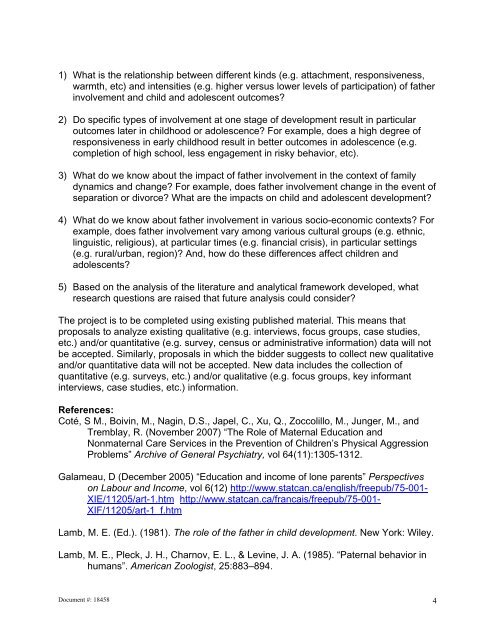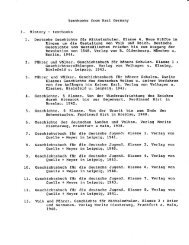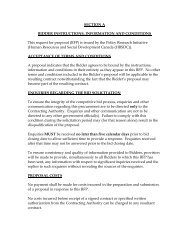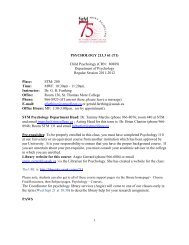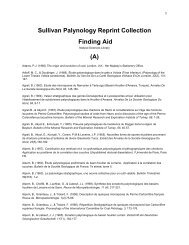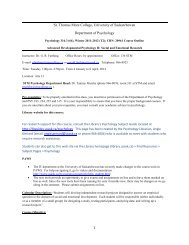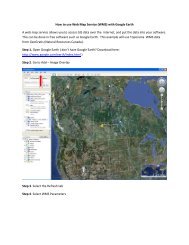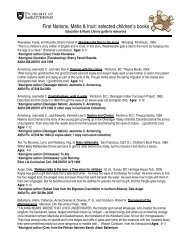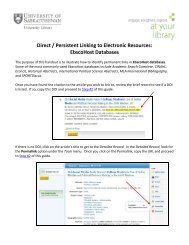Father involvement and child and adolescent ... - University Library
Father involvement and child and adolescent ... - University Library
Father involvement and child and adolescent ... - University Library
You also want an ePaper? Increase the reach of your titles
YUMPU automatically turns print PDFs into web optimized ePapers that Google loves.
1) What is the relationship between different kinds (e.g. attachment, responsiveness,<br />
warmth, etc) <strong>and</strong> intensities (e.g. higher versus lower levels of participation) of father<br />
<strong>involvement</strong> <strong>and</strong> <strong>child</strong> <strong>and</strong> <strong>adolescent</strong> outcomes?<br />
2) Do specific types of <strong>involvement</strong> at one stage of development result in particular<br />
outcomes later in <strong>child</strong>hood or adolescence? For example, does a high degree of<br />
responsiveness in early <strong>child</strong>hood result in better outcomes in adolescence (e.g.<br />
completion of high school, less engagement in risky behavior, etc).<br />
3) What do we know about the impact of father <strong>involvement</strong> in the context of family<br />
dynamics <strong>and</strong> change? For example, does father <strong>involvement</strong> change in the event of<br />
separation or divorce? What are the impacts on <strong>child</strong> <strong>and</strong> <strong>adolescent</strong> development?<br />
4) What do we know about father <strong>involvement</strong> in various socio-economic contexts? For<br />
example, does father <strong>involvement</strong> vary among various cultural groups (e.g. ethnic,<br />
linguistic, religious), at particular times (e.g. financial crisis), in particular settings<br />
(e.g. rural/urban, region)? And, how do these differences affect <strong>child</strong>ren <strong>and</strong><br />
<strong>adolescent</strong>s?<br />
5) Based on the analysis of the literature <strong>and</strong> analytical framework developed, what<br />
research questions are raised that future analysis could consider?<br />
The project is to be completed using existing published material. This means that<br />
proposals to analyze existing qualitative (e.g. interviews, focus groups, case studies,<br />
etc.) <strong>and</strong>/or quantitative (e.g. survey, census or administrative information) data will not<br />
be accepted. Similarly, proposals in which the bidder suggests to collect new qualitative<br />
<strong>and</strong>/or quantitative data will not be accepted. New data includes the collection of<br />
quantitative (e.g. surveys, etc.) <strong>and</strong>/or qualitative (e.g. focus groups, key informant<br />
interviews, case studies, etc.) information.<br />
References:<br />
Coté, S M., Boivin, M., Nagin, D.S., Japel, C., Xu, Q., Zoccolillo, M., Junger, M., <strong>and</strong><br />
Tremblay, R. (November 2007) “The Role of Maternal Education <strong>and</strong><br />
Nonmaternal Care Services in the Prevention of Children’s Physical Aggression<br />
Problems” Archive of General Psychiatry, vol 64(11):1305-1312.<br />
Galameau, D (December 2005) “Education <strong>and</strong> income of lone parents” Perspectives<br />
on Labour <strong>and</strong> Income, vol 6(12) http://www.statcan.ca/english/freepub/75-001-<br />
XIE/11205/art-1.htm http://www.statcan.ca/francais/freepub/75-001-<br />
XIF/11205/art-1_f.htm<br />
Lamb, M. E. (Ed.). (1981). The role of the father in <strong>child</strong> development. New York: Wiley.<br />
Lamb, M. E., Pleck, J. H., Charnov, E. L., & Levine, J. A. (1985). “Paternal behavior in<br />
humans”. American Zoologist, 25:883–894.<br />
Document #: 18458<br />
4


